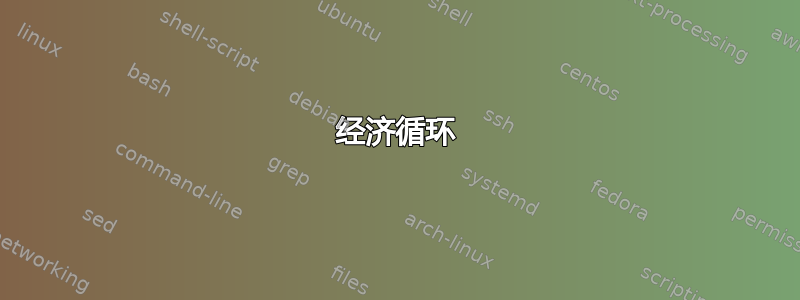
看过一些电子电路的例子后,我想制作一个像这样的经济型电子电路:

我没有找到任何相关的例子,所以希望得到您的帮助。
如果有人对经济学感兴趣,那么更具代表性的循环流程如下:

当我尝试创建第二个图形时,我遇到了一个问题,我的代码不起作用。
\documentclass[12pt,a4paper]{article}
\usepackage[english,greek]{babel}
\usepackage{ucs}
\usepackage[utf8x]{inputenc}
\usepackage[usenames,dvipsnames]{xcolor}
\usepackage{tikz}
\usepackage{tkz-tab}
\usetikzlibrary{shapes,snakes}
\usepackage{smartdiagram}
\usepackage{geometry}
\usetikzlibrary{positioning}
\geometry{left=0.75in,right=0.75in,top=0.65in,bottom=0.65in}
\usepackage{tkz-euclide}
\usetikzlibrary{shapes.geometric}
\usepackage{tkz-fct} \usetkzobj{all}
\usetikzlibrary{calc,decorations.pathreplacing}
\usetikzlibrary{decorations.markings}
\usepackage{pgfplots}
\usepackage{verbatim}
\usepackage{pgfplots}
\pgfplotsset{compat=1.9}
\usepackage{filecontents}
\usetikzlibrary{decorations.text}
\begin{document}
\begin{center}
\begin{tikzpicture}
\node (c1)[shape=circle,draw] {
$\left.
\begin{array}{c}
\textit{Επιχειρήσεις}\\
\textit{\footnotesize (Παραγωγοί)} \\
\end{array}
\right.
$
};
\node[rectangle,draw,rounded corners] (c2) [right=of c1] {Κράτος};
\node (c3) [shape=circle,draw] [right=of c2] {
$\left.
\begin{array}{c}
\textit{Νοικοκυριά}\\
\textit{\footnotesize (Καταναλωτές)} \\
\end{array}
\right.
$
};
\node(c4)[shape=circle,draw, above=of c2] {
$\left.
\begin{array}{c}
\textit{Αγορά}\\
\textit{Αγαθών}\\ \textit{Υπηρεσιών}
\end{array}
\right.
$
};
\node (c5)[shape=circle,draw, below=of c2] {
$\left.
\begin{array}{c}
\textit{Αγορά}\\
\textit{Παραγωγικών} \\
\textit{Συντελεστών}
\end{array}
\right.
$
};
\draw [<-,thick,color=Green] (c4) to [bend right=45] (c1);
\draw [<-,thick,color=Green] (c3) to [bend right=45] (c4);
\draw [<-,thick,color=Green] (c5) to [bend right=45] (c3);
\draw [<-,thick,color=Green] (c1) to [bend right=45] (c5);
\draw [->,thick, color=Red,postaction={decorate,decoration={raise=5ex,text along path,text align=center,text={ Δ}}}] (c4) to [bend left=45] (c1);
\end{tikzpicture}
\end{center}
\end{document}
答案1
该circuits库实际上不太适合这种图表。
这可以通过三个节点和一些边轻松实现。shapes.geometric库提供了ellipse形状。
该auto=right选项将所有节点沿路径放置在右侧(默认为左侧)。该swap选项仅将一个节点的此设置更改为另一侧。
代码
\documentclass[tikz, convert=false]{standalone}
\usetikzlibrary{shapes.geometric}
\begin{document}
\begin{tikzpicture}[
main node/.style={
draw,
shape=ellipse,
minimum width=2cm,
minimum height=1cm
},
>=latex,
auto=right
]
\node[main node] (daervz) {daervz};
\node[main node] (y) at (50:4) {y};
\node[main node] (x) at (130:4) {x};
\path[
nodes={font=\scriptsize},
->
] (x) edge[bend left=50] node[swap] {Goods} (y)
edge[bend right=50] node {ddaf} (daervz)
edge[bend right=10] node[swap] {z} (y)
(daervz) edge[bend right=50] node {dddda} (y)
edge[bend left] node {dda} (x)
(y) edge[bend left] node {dda} (daervz)
edge[bend left] node {k} (x)
edge[bend right] node {z} (x)
;
\end{tikzpicture}
\end{document}
输出

答案2
使用 PSTricks。只是为了好玩!
\documentclass[preview,border={10pt 10pt 10pt 40pt}]{standalone}
\usepackage{pst-node}
\def\obj#1{\makebox[1cm]{\strut#1}}
\begin{document}
\offinterlineskip
\begin{psmatrix}[colsep=1cm,rowsep=3cm,mnode=oval]
[name=l]\obj{x} & & [name=r]\obj{y}\\
& [name=b]\obj{daervz} \\
\end{psmatrix}
\psset{arrows=->}
% upper connections
\ncarc[arcangle=40]{l}{r}\naput{Goods}
\ncarc[arcangle=-20]{r}{l}\nbput[labelsep=3pt]{z}
\ncarc[arcangle=-20]{l}{r}\naput{z}
\ncarc[arcangle=50]{r}{l}\nbput[labelsep=3pt]{k}
% left connections
\ncarc[arcangle=-50]{l}{b}\nbput{ddaf}
\ncarc[arcangle=20]{b}{l}\nbput{dda}
% right connections
\ncarc[arcangle=-50]{b}{r}\nbput{dddda}
\ncarc[arcangle=20]{r}{b}\nbput{dda}
\end{document}

简化版本:
我们可以使用shortput=nab如下选项来节省更多的击键。
\documentclass[preview,border={10pt 10pt 10pt 40pt}]{standalone}
\usepackage{pst-node}
\def\obj#1{\makebox[1cm]{\strut#1}}
\begin{document}
\offinterlineskip
\begin{psmatrix}[colsep=1cm,rowsep=3cm,mnode=oval]
[name=l]\obj{x} & & [name=r]\obj{y}\\
& [name=b]\obj{daervz} \\
\end{psmatrix}
\psset{arrows=->,shortput=nab}
% upper connections
\ncarc[arcangle=40]{l}{r}^{Goods}
\ncarc[arcangle=-20]{r}{l}_[labelsep=3pt]{z}
\ncarc[arcangle=-20]{l}{r}^{z}
\ncarc[arcangle=50]{r}{l}_[labelsep=3pt]{k}
% left connections
\ncarc[arcangle=-50]{l}{b}_{ddaf}
\ncarc[arcangle=20]{b}{l}_{dda}
% right connections
\ncarc[arcangle=-50]{b}{r}_{dddda}
\ncarc[arcangle=20]{r}{b}_{dda}
\end{document}


